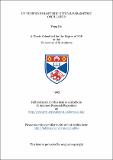UV pumped holosteric optical parametric oscillator
Abstract
The all-solid-state (or "holosteric") optical parametric oscillator has resulted from the recent development of diode-laser-pumped solid-state lasers and from recent advancements in new optically nonlinear materials. As a result, all-solid-state sources of widely tunable (ultraviolet - visible - near infrared) coherent radiation are now possible by using the radiation from diode-laser-pumped solid-state lasers, either directly or after frequency conversion, to pump optical parametric oscillators. Such devices can be made compact, efficient and reliable. The work described in this thesis explores the feasibility of obtaining widely tunable radiation from such devices, with particular reference to low threshold, high efficiency operation, so requiring only modest energies (1 mJ in ultraviolet) from the pump source. In particular, a frequency tripled or frequency quadruped Nd:YAG laser pumped by pulsed, GaAlAs diode laser bars has been used as the pump source, and lithium triborate has been used as the nonlinear medium in the optical parametric oscillator. Two geometries of lithium triborate crystals have been investigated as the nonlinear medium. One was cut for a type II non-critical phase matching geometry, while the other was cut for a type I critical phase matching geometry. The oscillator cavities were designed for optimum focusing and mode matching aiming for operation with a low pump energy through the use of tightly focused pump radiation. The ultraviolet pump source was based on a Q-switched diode-laser-pumped Nd:YAG laser which generated pulses at 1.064 mum with energy 10 mJ and duration around 10 ns. These were then frequency up-converted to the UV at 355 nm or 266 nm, so as to be suitable for pumping the parametric oscillators. Generally, an overall conversion efficiency from 1.064 mum to 355 nm of >30% was obtained using the nonlinear materials potassium titanyl phosphate and lithium triborate for second harmonic generation and sum-frequency mixing respectively. For conversion to 266 nm, an overall efficiency of > 18 % was obtained using the nonlinear materials KTP and BBO for two step second harmonic generation. In the experimental investigations of the all-solid-state lithium triborate optical parametric oscillator pumped at 355 nm a low oscillation threshold was obtained in the type II non-critical phase matching geometry (around 0.2 mJ) and pump depletions of 50 % were obtained at around six times threshold. This device could be temperature tuned (20 - 200 °C) from 457 to 481 nm (signal wave) and 1.6 to 1.35 mum (idler wave). Optimised focusing conditions corresponding to the theory of Guha et al were approached in the type I phase matching geometry, and despite the existence of a 1° walkoff angle, the minimum oscillation threshold was measured to be around 0.3 mJ. Generally, pump depletions of about 35 % were obtained, at around four times threshold. These devices could be angle tuned (through crystal internal angle 14°) from 457 to 666 nm (signal wave) and 1.6 mum to 768 nm (idler wave). (The whole of the range 420 nm to 2.3 mum could be covered with such a device given additional mirror sets). The all-solid-state type II geometry lithium triborate optical parametric oscillator was also pumped at 266 nm, when it was temperature tunable (20 - 200 °C) from 306 to 314 nm (signal wave) and 2.03 to 1.75 mum (idler wave). Pump depletions of 25 % were demonstrated with this device at pump energies of four times threshold. In addition to the above experimental investigations, the thesis addresses the issues of (i) choice of nonlinear material for optical parametric oscillators in terms of appropriate figures of merit, and (ii) optimisation of pump and resonated wave focusing parameters. Reviews of the appropriate theoretical background to phase matching geometries and optical parametric interaction are included.
Type
Thesis, PhD Doctor of Philosophy
Collections
Items in the St Andrews Research Repository are protected by copyright, with all rights reserved, unless otherwise indicated.

